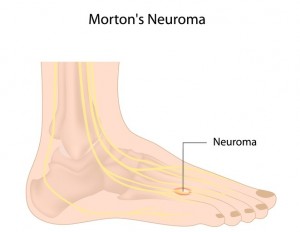Morton’s Neuroma
 What is a Morton’s neuroma?
What is a Morton’s neuroma?
A Morton’s neuroma, also referred to as an intermetatarsal neuroma, is a swollen, inflamed nerve that appears in the ball of the foot between the metatarsal bones, which are located at the base of the toes. Typically, these neuromas develop between the third and fourth toes. The condition produces persistent pain in the ball of the foot. There are different types of neuromas that may develop in the foot, but a Morton’s neuroma is the most common.
What causes a Morton’s neuroma?
A Morton’s neuroma occurs due to continual compression of the nerve between the metatarsal bones, which results in inflammation and swelling. Most often, ill-fitting shoes that bind the forefoot cause this condition.
What are the symptoms of a Morton’s neuroma?
If you have a Morton’s neuroma, you will likely experience:
- Persistent pain or numbness in the ball of the foot
- Pain or numbness which radiates to the nearby toes
- A feeling that something is stuck inside the ball of the foot or on your shoe’s footbed
- Pain that worsens when walking
- Pain that worsens when the ball of the foot is squeezed together, such as when wearing tight or pointy-toed shoes
The pain may cause you to walk with a limp or minimize the time spent on your feet due to the discomfort it causes.
What are the risk factors for a Morton’s neuroma?
There are several factors that can increase your risk for a Morton’s neuroma:
- Gender – the incidence of a Morton’s neuroma is 8 to 10 times greater in women than in men
- Ill-fitting footwear – shoes that are too tight, narrow or shoes with high heels can bind the foot and result in a Morton’s neuroma
- Foot anatomy – certain foot conditions including bunions, hammertoes and flat foot may place you at a higher risk for developing a neuroma
What are the treatment options for a Morton’s neuroma?
If you are experiencing persistent pain in the ball of your foot, call our office at 212‑434‑4920 or fill out the schedule appointment form on this page to get a proper diagnosis before your symptoms worsen. A Morton’s neuroma is fully treatable without surgery for most patients and treatment outcomes are significantly improved if medical evaluation is sought when symptoms first start.
Nonsurgical Treatment
Nonsurgical treatment options may take several months to fully take effect, depending on which course(s) of treatment you take and how long you were experiencing pain prior to seeking medical attention.
Nonsurgical treatment options may involve:
Resting
The first and most important step to recovery is stopping or reducing all activities that make the pain worse, particularly those activities that place repetitive pressure on the neuroma.
Applying ice
Applying ice to the affected area will help reduce pain and swelling.
Taking anti-inflammatory medications
Taking over-the-counter anti-inflammatory medications can considerably reduce pain. If necessary, Dr. Katchis may prescribe a stronger medication to help with inflammation and pain.
Altering footwear
Trade out tight shoes and high heels for wider shoes with soft, supportive soles. A wider foot bed and comfortable insole will allow the injured foot to spread out, reducing pressure on the nerve and allowing it to heal.
Using orthotics
Inserts placed in the shoes can help relieve pain and swelling by repositioning the foot and reducing pressure on the neuroma.
Getting cortisone injections
Cortisone shots injected into the affected area may significantly reduce pain and discomfort.
Surgical Treatment
If conservative treatment options do not relieve symptoms after several months, Stuart Katchis, M.D. may recommend foot neuroma surgery. The surgery for Morton’s neuroma typically involves the foot and ankle surgeon resecting (cutting out) a portion of the inflamed nerve or releasing the tissue around the nerve.
What does the recovery process entail?
Recovery times will vary depending on the severity of each patient’s condition. Whether you undergo nonsurgical or surgical treatment for your foot neuroma, Dr. Katchis will provide recommendations for long-term measures designed to keep your symptoms from returning, such as footwear modifications and stopping activities that place repetitive pressure on the foot.




You must be logged in to post a comment.